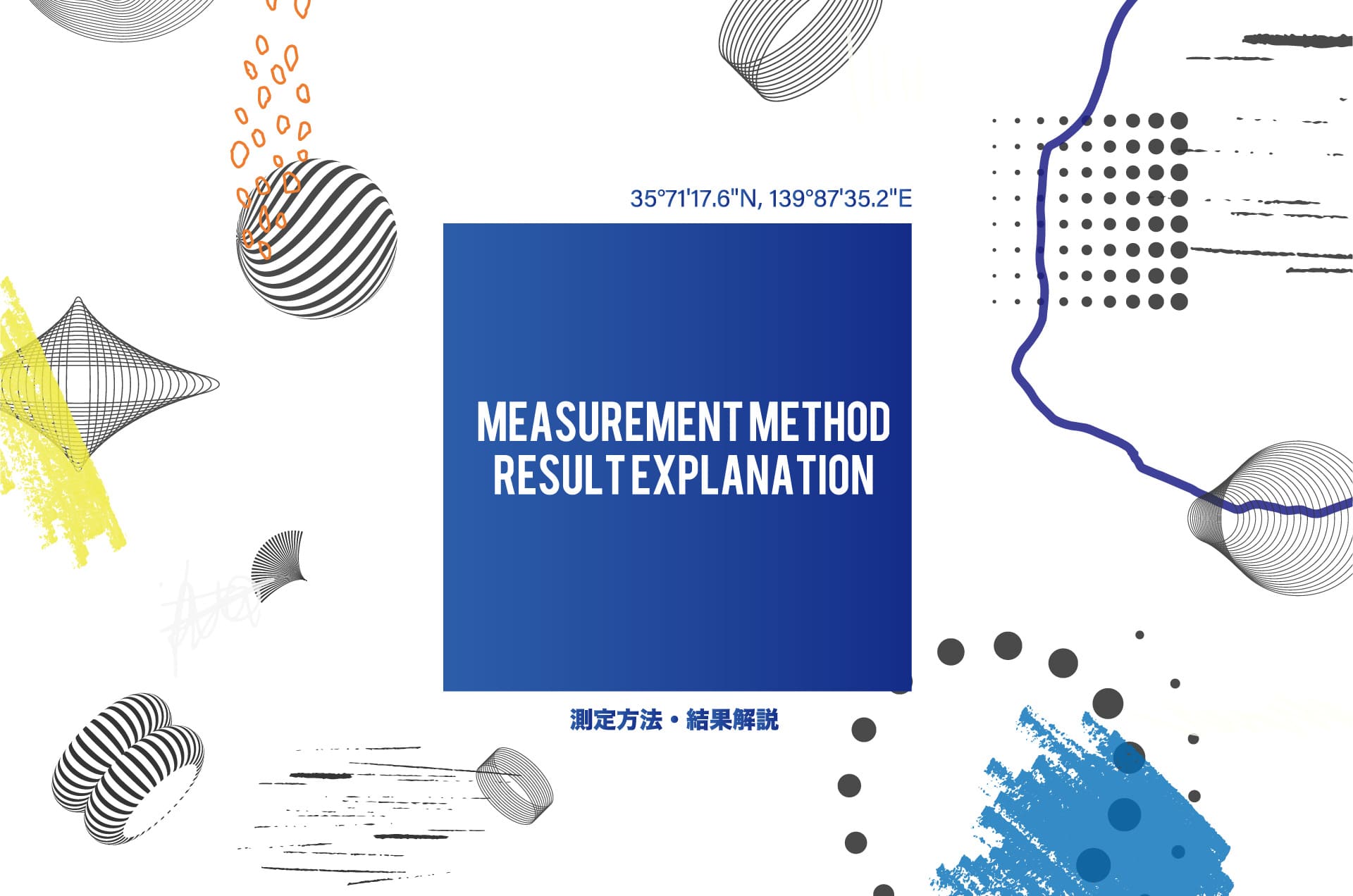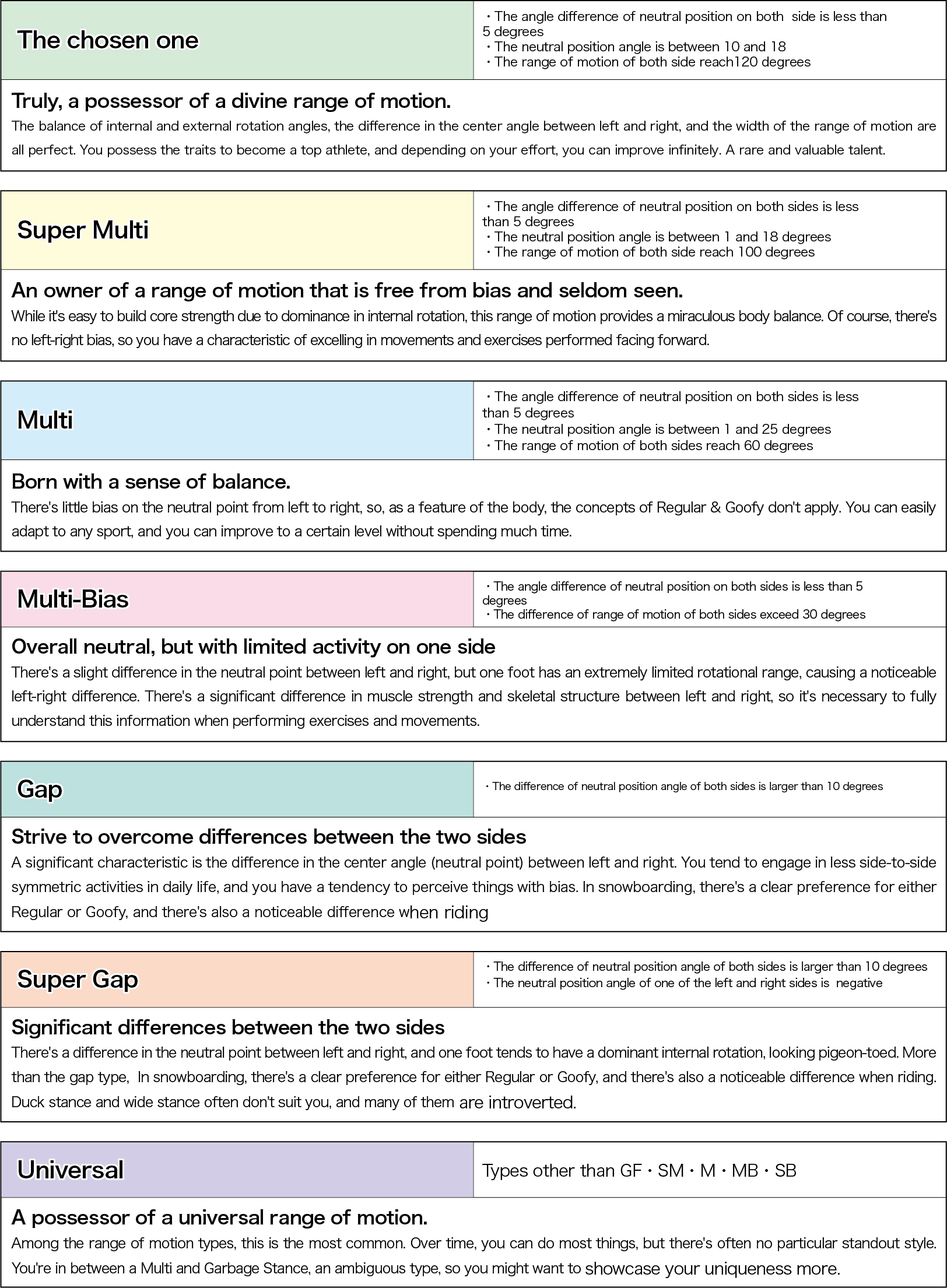- What is Snowboard STANCER?
- Measured Result Explaination

Measured Result Explaination
EXPLAINATION OF
MEASUREMENTRESULTS
-
1st Sheet Explanation
-

※ The test date indicates the date the test was conducted, and the test location is the name of the shop the test was carried out in.
-

Ⓐ Displays the center angle of the rotational range of motion (Neutral Point: NP value) for both left and right hip, calculated from the average value of the lower limb rotational movement.
Ⓑ Displays the average value of the maximum angle on the outside of the left foot from the lower limb rotational movement.
Ⓒ Displays the average value of the maximum angle on the inside of the left foot from the lower limb rotational movement.
Ⓓ Displays the average value of the maximum angle on the inside of the right foot from the lower limb rotational movement.
Ⓔ Displays the average value of the maximum angle on the outside of the right foot from the lower limb rotational movement.
Ⓕ This is waveform data measured from 13 seconds of rotational movement. The internal and external rotation is repeated every second, and the angle of the peak point from that waveform data is averaged to give the range of motion of the internal and external rotation of the left and right hip.
Ⓖ The range of motion of the lower limb's rotation is presented in the form of a protractor. The two short arrows on the outside represent the maximum values of internal and external rotation. The long arrow in the center represents the neutral point.
-

Ⓗ Annotations for this test result are provided. The blue box within the blue box will have varying annotations based on the result. Recommendations for posture inferred from physical characteristics and basic recommended stance width are described.
-

Ⓘ Displays personal data entered before the test. Age and weight are not shown but are reflected in the test results.
-

Ⓙ The recommendations for this test (range of motion) and the personal data calculations offer a total of three stance settings. The displayed stance setting will vary based on the snowboarding style preference selected before the test.
If you wish to view recommended settings for other snowboarding preferences, you can check these in the "stance.lab" feature of the yukiyama app.
Ⓚ An explanation of the force lines of Magic Sole has been provided.
https://youtu.be/CTSg_tOgiew -

Ⓛ The center positioning of the strap for adjustment is based on the measured central angle (neutral point) and foot length. Different strap adjustment positions are recommended and displayed graphically.
-
2nd Sheet Explanation
-

※ The Subject Code is the unique code corresponding to this measurement. It will be needed when making inquiries via direct messaging.
The test date indicates the date the test was conducted, and the test location is the name of the shop the test was carried out in. -

Ⓟ Displays the details of the measured maximum point of the range of motion, accurate to 0.1 degrees. The numbers encircled by ○ represent the average values taken during the measurement. Furthermore, the average of these three values is displayed below as the range of motion.
-

Ⓠ Shows the precision of the range of motion, represented in percentage terms. For the three values shown and circled in P, if the variation is small, the precision is high, indicating that the tested individual has a high level of control over the range of motion. If there is a significant variation, the precision is low, indicating that the individual might not have full control yet.。
-

Ⓡ Displays the level of the range of motion. The numbers for left external rotation, left internal rotation, right internal rotation, and right external rotation are added together. This sum is then multiplied by the precision of the range of motion to obtain an INDEX, which is then assessed based on a 10-level ROM (Range of Motion) level.
-

Ⓢ Displays the type of range of motion and provides an overview of this type. Explanations are based not only on physical or movement characteristics but also on inferred personal lifestyle patterns.
-

Ⓣ Based on the measurement results, personal data, and snowboarding style preferences, it displays detailed information about the recommended gear (snowboard boots). It shows the size, type, and flexibility of the snowboard boots, which can be referred to when purchasing a snowboard.
-

Ⓤ Using the measurement results, personal data, and snowboarding style preferences, this displays detailed information about the recommended gear (snowboard). It shows the length, shape, torsion, and flexibility of the snowboard, which can be referred to when purchasing a snowboard.
-

Ⓥ Within the Yukiyama APP, the STANCER feature, "stance.lab" displays a QR code of the measurement data.
-

Ⓦ The concept of STANCER is explained in text.
-

Ⓧ Displays the contact information for inquiries regarding STANCER measurements. Please consult via direct messages on Twitter and Instagram. At this time, you will need to provide the Subject Code mentioned below.
-
Range of motion type

-
-
22/23 Update Explanation Video
-